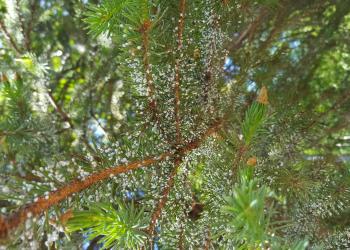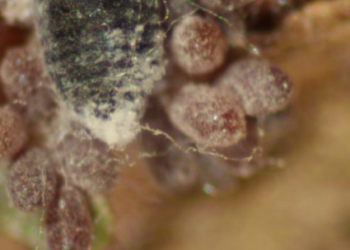Balsam Woolly Adelgid
Adelges piceae Ratzeburg
Host(s) in Alaska:
- Native hosts: Subalpine fir (Abies lasiocarpa) & Pacific silver fir (Abies amabilis)
- Ornamental hosts: balsam fir (Abies balsamea), Fraser fir (Abies fraseri), & grand fir (Abies grandis)
General Distribution in Alaska: Invasive species, as of 2024 it has only been found in Juneau, Alaska.
Current Status & Distribution in Alaska (2024)
No new observations in 2024; 4 of the infested trees identified on private property in Juneau in 2020 were recently removed.
Ground Detection Survey Observations: None.
ADS Observations: None.
iNaturalist Observations: None.
Historic Activity
The distribution of balsam woolly adelgid from the USDA-FS Alien Pest Explorer. This map excludes the recent detection in Juneau, Alaska.
(USDA Forest Service, Northern Research Station and Forest Health Protection. Alien Forest Pest Explorer- Balsam Woolly Adelgid Map (2/13/2020))Balsam woolly adelgids were introduced to northeastern United States from Europe around 1900. They were found on the west coast in 1929 and the southeastern United States in the mid-1950s. Infested nursery stock is the presumed source of infestation. This invasive insect was first detected in Alaska in June 2019. At this time, it has only been detected in Juneau, AK.
Balsam woolly adelgids are native to Europe and have been introduced to several locations within the United States. This invasive species is a small sap-sucking insect that feeds on fir trees and can kill a tree within a few years. Adult adelgids produce a white waxy coating to protect them and their eggs from predators. Balsam woolly adelgid can be spread by the movement of plants in the nursery trade, firewood, or Christmas trees. Firs do not occur naturally in the Juneau area but are popular ornamental trees. Subalpine fir and Pacific silver fir are native to other parts of Southeast Alaska.
Subalpine fir with reddish-brown needles cause by balsam woolly adelgid feeding.
(USDA Forest Service photo.)Balsam woolly adelgid was found infesting ornamental true fir in Juneau, AK in 2019, which was the first known detection in Alaska. The City and Borough of Juneau moved quickly to remove all 36 true fir on city property and destroy the infested material. Several infested trees remain on private properties in Juneau. The Alaska Division of Forestry is developing a cost-share program to assist Juneau home and business owners with removal of infested trees.
In 2020, the University of Fairbanks Cooperative Extension service and the Alaska Division of Forestry investigated a report of suspected woolly adelgids on several long-established lodgepole pines in the Big Lake area. Since lodgepole pine are not native to the region, these adelgids are of particular interest. During a site visit, specimens were collected from infested trees and sent to a specialist for DNA-based identification. The species was confirmed as Pineus coloradensis. The adelgids were most prevalent on numerous potted lodgepole pine seedlings described by the landowner as being the natural regeneration of several long-established larger lodgepole pines. It is unclear whether this adelgid species occurs naturally in the state or if it may have been introduced. Further investigation is needed.
No new infestations of balsam woolly adelgids were found in 2022.
Please help contain this invasive species: if you have an ornamental fir tree and are in Juneau, AK contact entomologist Dr. Elizabeth Graham to have it inspected for balsam woolly adelgids.
Balsam woolly adelgid feeds on cells just beneath the bark of trees and can be found on twigs, branches, and trunks of trees. Feeding damages the tissue that transports food and water and can result in needle loss and reduced growth. Twigs may become enlarged, referred to as “gouting”, and shoots can become distorted and turn downward. Heavy or prolonged attacks often lead to tree death.
- Tree-level impacts: Reduced growth and stunting of the whole tree or branches. This may be obvious or subtle. Trees may develop a fiddle-shaped top.
- Trunks: balsam woolly adelgid can be identified by specks of white woolly wax that cover mature female adelgids. Adelgids not producing waxy threads can be difficult to see without magnification.
- Shoots: feeding causes gout-like growth (swellings) of twigs and shoots, especially at branch junctions.
- Needles: balsam woolly adelgids do not infest needles, but branch feeding can cause older needles to turn yellow or bronze.
Mechanical Control
- Only cut and remove infested trees when adelgids are not active (December-February).
- Cut and remove infested trees as close to the ground as possible.
- Grind and remove stump.
- Chip all materials.
Chemical Control
Be judicious in your use of pesticides to control balsam woolly adelgid. Because of the nature of balsam woolly adelgid, pesticide applications are not guaranteed to be 100% effective. Insecticides can decrease populations and limit the amount of damage done to the tree, but they will often require repeat applications to keep adelgids at low populations and may not fully eradicate the pests from the tree. Any pesticide application for balsam woolly adelgid is best suited for individual, high-value, ornamental trees. Many products are available that can be used to treat trees for balsam woolly adelgid. The table below lists some active ingredients and example products.
Applications for balsam woolly adelgid typically fall into one of two categories:
1) Products that are applied to the tree and work against the pest when the pest contacts the product.
Thorough coverage is key to application success. Treat trunks and limbs of the tree with a high-pressure sprayer when crawler stage BWA are active. Monitor for crawlers in late spring/early summer and again in fall and time treatments based on monitoring. For products with shorter residual in the environment, timing the application is very important and routine monitoring is key.
2) Systemic products that are taken up by the tree and act against the pest when the pest feeds on them.
We have limited information on the effectiveness of systemic insecticides against balsam woolly adelgid. Related insects tend to be very susceptible to these products; however, balsam woolly adelgid feeds on a very different part of the tree than most other target pests, and the feeding they do may actually inhibit the tree’s ability to move a systemic product. If systemic products are used, they may be most effective on very light, very early infestations or as preventive measures on uninfested trees. Systemic products can be applied in several ways. Some products are applied to the root zone of the tree either by drenching the soil or injecting the product into the soil and are designed to be taken up by the tree’s roots. Some products are designed to be sprayed onto the lower portion of the trunk and absorbed into the tree’s vascular system and moved to other parts of the tree. The rate of application of a product is typically based on tree size and will be listed on the product label.
For any pesticide application, take the time to understand the products and applications in order to make the best decisions for your tree(s) and your property. For specific questions about products or questions about treatments on your tree(s) or property, contact your local Cooperative Extension Service office.
Balsam Woolly Adelgid Control: Active ingredients, Application type/s, and Example products*
Some products may be labeled as Restricted Use Pesticides and only available to certified pesticide applicators.
*Trade names listed here are meant as examples of products containing the specific active ingredient. Presence in this list is not an endorsement of the product; absence from the list does not indicate unavailability or ineffectiveness of a product.
For any pesticide application, follow all label recommendations for use rate and application. Remember, the label is the law!
Goheen, E.M. and E.A. Willhite. 2006. Field Guide to Common Diseases and Insect Pests of Oregon and Washington Conifers. R6-NR-FID-PR-01-06. Portland, OR: USDA Forest Service, Pacific Northwest Region. 337 pp. Available here.
Hrinkevich, K.H., R.A. Progar, and D.C. Shaw. 2016. A severity rating system for evaluating stand-level balsam woolly adelgid (Hemiptera: Adelgidae) damage in two Abies species in western North America. For Sci. 62(2): 181–189. Available here.
Hrinkevich, K.H., R.A. Progar, and D.C. Shaw. 2016. Climate risk modelling of balsam woolly adelgid damage severity in subalpine fir stands of western North America. PLoS ONE 11(10): e0165094. doi:10.1371/journal.pone.0165094. Available here.
Mitchell, R.G. 1966. Infestation characteristics of the balsam woolly aphid in the Pacific Northwest. USDA Forest Service, Pacific Northwest Forest and Range Exp. Sta., Portland, OR. Research Paper, PNW-35. 18 pp. Available here.
Mitchell, R.G., and P.E. Buffam. 2001. Patterns of long-term balsam woolly adelgid infestations and effects in Oregon and Washington. West. J. Appl. For. 16(3)121-126. Available here.
Ragenovich, I.R. and R.G. Mitchell. 2006. Balsam woolly adelgid. Forest Insect & Disease Leaflet 118 (revised). USDA Forest Service, Washington, D.C. 11p.
USFS Region 6 balsam woolly adelgid webpage
For more information, please contact Dr. Elizabeth Graham, Entomologist, Forest Health Protection, elizabeth.e.graham@usda.gov.









